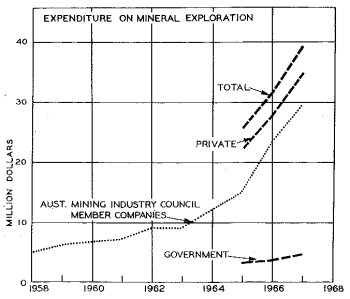Geology in Practice. Presidential Address Section 3, Geology, ANZAAS Meeting
The Snowy Mountains Scheme provided an exceptional opportunity for geologists to work with engineers over a period of 20 years on many large and varied projects in all their phases of development from initial investigations and planning through detailed design, into constrhalf-pageuction and operation. The Tasmanian Hydro-electric Commission continues to provide a similar opportunity. It is of great importance for the efficient execution of future water development projects that such groups be held together. Dispersed as individuals the intangible but very real team value would be lost.
Mineral Exploration
The great upsurge in mineral exploration which is occurring in Australia is well illustrated by the sharply rising curve of expenditure. Expenditure on mineral exploration excluding oil and gas, by private companies, has multiplied tenfold in the past 11 years from about $5 million in 1958, to $35 million in 1967, and to an estimated current rate of much more than $50 million a year. These amounts do not include expenditure on exploration for oil and gas, which was $74 million in 1967, nor do they include the very high costs of development of discoveries. There has been a particularly rapid acceleration from about 1965. Since then expenditure on exploration has doubled and the curve is still continuing to rise very steeply with no signs of flattening.

Figure 1
Expenditure on mineral exploration.
In mineral exploration it is logical that geologists should play the leading technical role since mineral deposits are geological entities and the search for them is essentially a geological activity, although involving as well as geologists, specialists in geophysics, geochemistry and geobotany backed up by analytical chemists, metallurgists, mining engineers and others.
While mineral exploration ventures may be initiated by anyone, the practical task of ensuring that exploration is competently executed is primarily the
